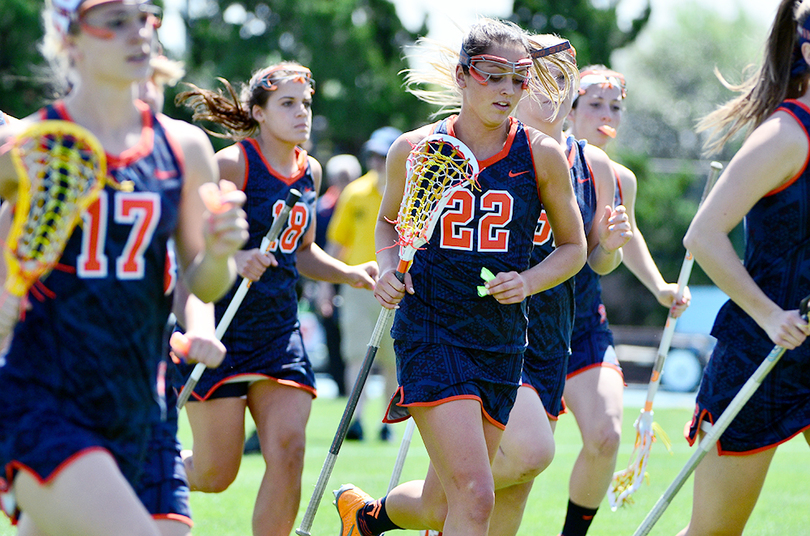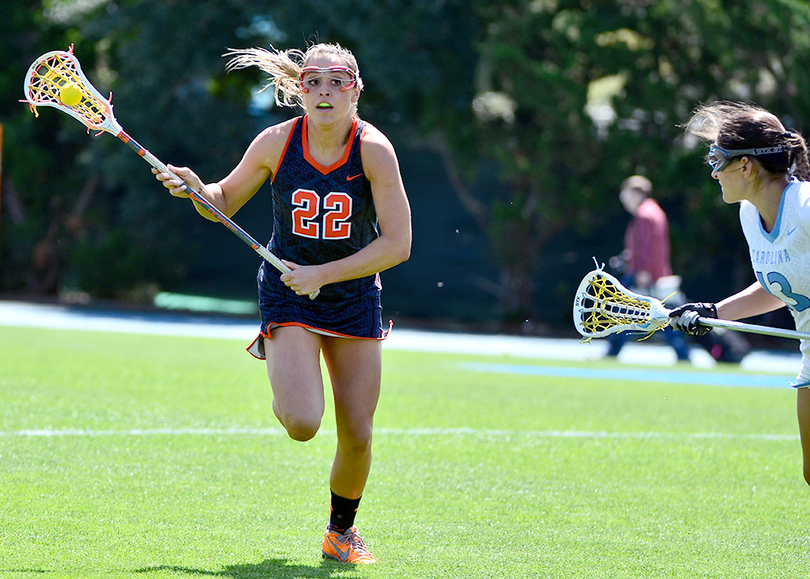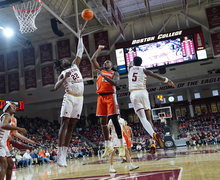Syracuse’s Taylor Gait persists through multiple knee injuries, keeps promise to play for father, Gary Gait
Taylor Gait knew it. Her mother knew it. And her father knew it.
It made him sick, and Nicole Gait said it was written on her husband’s face.
Sitting on the Manley Field House turf, Taylor pleaded, “Why me?” while tears streamed down her face. On that play during Syracuse’s alumni game in late January 2014, the then-sophomore had torn her right ACL and meniscus for the first time.
“This was my time, I was going to be so good,” Taylor confided to her mother in the training room, “I was ready. My (left) knee was so good.”
Since the first time Taylor tore her left ACL and meniscus in late April 2011, she had not played a full regular-season lacrosse game until this season because of her seven combined knee injuries. Despite her mother telling her it was OK to stop playing, the junior midfielder has played in every game this season and scored 16 goals.
Five of the six procedures required to repair Taylor’s knees have been on her left one. Another left knee injury could end her career. Doctors told her another surgery would be too invasive, yet she could possibly play another three years thanks to a redshirt freshman year and a pending NCAA waiver for a sixth year of eligibility.
And by persistently returning to the field, she has been able to fulfill a promise she made to play for her father, SU head coach Gary Gait, who etched his name in SU history as one of the greatest men’s lacrosse players ever.
“I think to her it was a light at the tunnel, like, ‘I’m going to do this. I’m going to play for my dad,’” Nicole Gait said. “‘My dad came here because I was going to play for him, so I’m going to make it work. What do I need to do?’”
In the summer of 2007, Taylor and Gary talked at the kitchen table while the family still lived in Denver. Her father wanted to coach the SU women’s team, and he wanted Taylor to play for him there. She played for Real Colorado, a soccer club with nearly 5,000 players and was reluctant to move to Syracuse, but lacrosse coursed through her family’s veins.
It was then that the two made a promise to team up at SU, and that promise has driven her ever since.
The first time she tore her left meniscus and ACL, nobody touched her as she sat crying on the lacrosse field at Christian Brothers (New York) Academy as a high school junior.
Twenty minutes passed, she said. Gary was on a bus at Syracuse, leaving for an away game, and her mother was teaching dance at their house.
A teammate’s father shooed away first responders, Taylor said. When she had to be on bed rest for two weeks after the surgery, Taylor wanted to move around, even to just have her friends drive her around the block, but couldn’t move.
“I had never been hurt before,” Taylor said. “… When it happened, I was like, ‘I don’t even know how to be injured. I don’t know. Why can’t I play?’”
After surgery and rehab, her father noticed she couldn’t fully extend her leg, and she experienced nerve pinching in her left leg. Both effects have yet to subside, she said.
Taylor rehabbed until late March 2012, when she returned for her high school senior season. In her first weekend back, she pulled herself off the field because something was wrong with her knee.
She eventually visited three doctors. Each told her they couldn’t figure out what exactly was wrong, but she had likely torn her meniscus again.
Leslie Matthews, an orthopedic surgeon for the Baltimore Ravens, repaired Taylor’s meniscus in March 2012. She woke up from the anesthesia freezing cold — a unique reaction to the surgical drug — and soon cried. Matthews found her left ACL was partially torn and she’d have to come back in two weeks for another surgery.
She decided to redshirt her freshman year at Syracuse. Then warming up for a home game she couldn’t even play in, her left knee gave out on a simple cut. This time she tore just her left meniscus. Her left knee developed scar tissue, so Matthews cleaned it out twice in the summer of 2013.
Taylor rehabbed again, and things were going well until the alumni game. Within a week of tearing her ACL, she found herself under Matthews’ knife again.
“We were leaving the next day to play our first game and she tore her good knee,” Gary said. “That was kind of heartbreaking.”
Through each injury, Nicole reminded her daughter that lacrosse did not have to define her.
But she still returned to sports, attending every CBA soccer practice even though she couldn’t play her senior year. At SU, she scheduled physical therapy around practice so that she could throw a lacrosse ball around and fine-tune her stick work, so she was still improving although she couldn’t play.
After she tore her left ACL and meniscus a second time, Taylor and her mother talked about whether she needed to come back to lacrosse again. Taylor questioned whether she wanted to come back, but didn’t waver.
“I said to her once, ‘You are so much more than lacrosse… Who cares?’” Nicole said.
“‘Mom, I’m going to play again,’” Nicole said her daughter told her. “‘Stop saying that. I will play.’”
And Taylor has.
While she’s regained the ability to run, it has taken baby steps to get back into lacrosse.
She played on the second midfield line in SU’s first game against Denver on Feb. 6, tallying a goal and an assist. Then she cracked the starting lineup against Florida on March 10, scoring a goal.
On April 7, she finally emerged. She scored a hat trick in a four-minute span to bring SU back in an eventual loss against Notre Dame.
After the game, her mother sat in the bleachers. Nicole occasionally surveyed the then-empty Carrier Dome turf. Her eyes began to well up.
“Six surgeries, four years not playing and then you see what she’s doing,” Nicole said. “… It’s amazing to me.”
Taylor sometimes runs four miles after practice, even though she says she shouldn’t.
But to this point, the injuries haven’t stopped her. Not from running. Not from playing lacrosse. And not from carrying out her promise to her father.
“Me and my dad have a special relationship,” Taylor said. “I feel like he’s the one motivating me every time.”
Published on April 15, 2015 at 10:52 pm
Contact Chris: cjlibona@syr.edu | @ChrisLibonati







